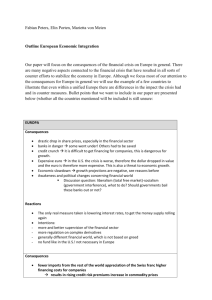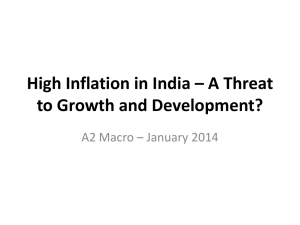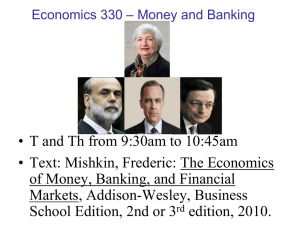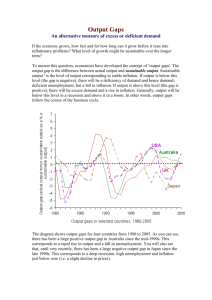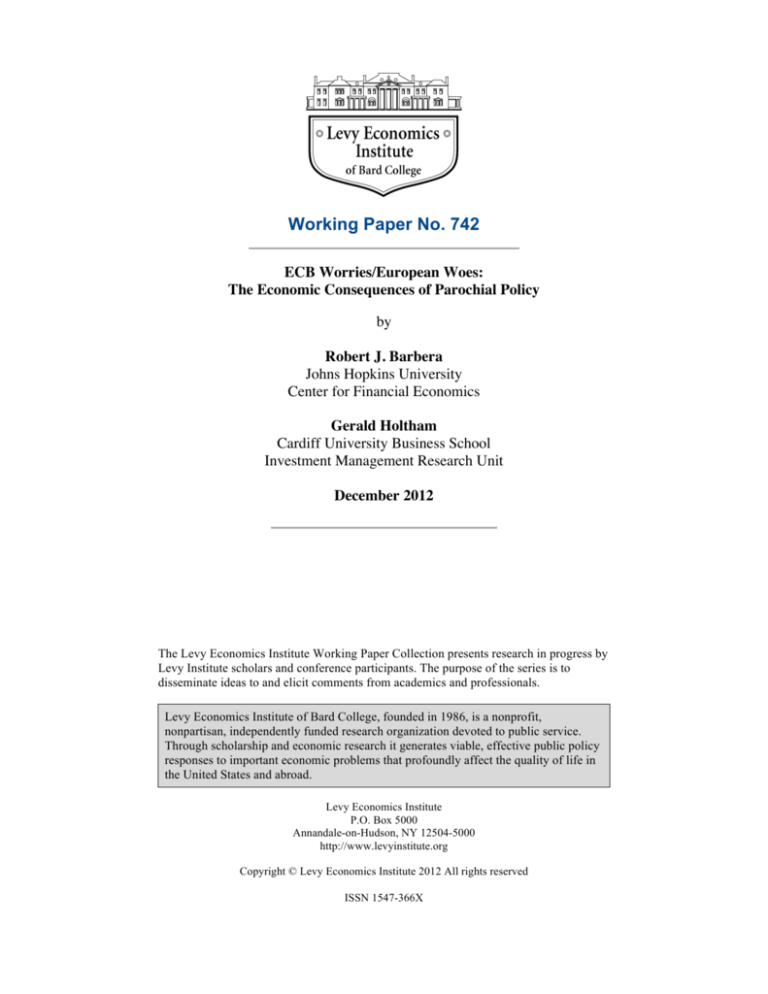
Working Paper No. 742
ECB Worries/European Woes:
The Economic Consequences of Parochial Policy
by
Robert J. Barbera
Johns Hopkins University
Center for Financial Economics
Gerald Holtham
Cardiff University Business School
Investment Management Research Unit
December 2012
The Levy Economics Institute Working Paper Collection presents research in progress by
Levy Institute scholars and conference participants. The purpose of the series is to
disseminate ideas to and elicit comments from academics and professionals.
Levy Economics Institute of Bard College, founded in 1986, is a nonprofit,
nonpartisan, independently funded research organization devoted to public service.
Through scholarship and economic research it generates viable, effective public policy
responses to important economic problems that profoundly affect the quality of life in
the United States and abroad.
Levy Economics Institute
P.O. Box 5000
Annandale-on-Hudson, NY 12504-5000
http://www.levyinstitute.org
Copyright © Levy Economics Institute 2012 All rights reserved
ISSN 1547-366X
ABSTRACT
Financial market crises with the threat of a subsequent debt-deflation depression have occurred
with increasing regularity in the United States from 1980 through the present. Almost
reflexively, when confronted with such circumstances, US institutions and the policymakers that
run them have responded in a fashion that has consistently thwarted debt-deflation-depression
dynamics. It is true that these “remedies,” as they succeeded, increasingly contributed to a moral
hazard in US and global financial markets that culminated with the crisis that began in 2007.
Nonetheless, the straightforward steps taken by established institutions enabled the United
States to derail depression dynamics, while European 1930s-style austerity proved as ineffective
as it was almost a century ago. Europe’s, and specifically Germany’s, steadfast refusal to
embrace the US recipe has fostered mushrooming economic hardship on the continent. The
situation is gruesome, and any serious student of economic history had to have known, given
European policy commitments, that it was destined to turn out this way.
It is easy to understand why misguided policies drove initial European responses.
Economic theory has frowned on Keynes. Economic successes, especially in Germany, offered
up the wrong lessons, and enduring angst about inflation was a major distraction. At the outset,
the wrong medicine for the wrong disease was to be expected.
What is much harder to fathom is why such a poisonous elixir continues to be proffered
amid widespread evidence that the patient is dying. Deconstructing cognitive dissonance in
other spheres provides an explanation. Not surprisingly, knowing what one wants to happen at
home completely informs one’s claims concerning what will be good for one’s neighbors. In
such a construct, the last best hope for Europe is ECB President Mario Draghi. He seems to be
able to speak German and yet act European.
Keywords: Austerity; Central Banks; Economic Stability; Euro; European Central Bank;
Eurozone; Eurozone Debt Crisis; Financial Crisis; Financial Instability; Financial Markets;
Fiscal Policy; Government Policy and Regulation; Hyman Minsky; Sovereign Debt;
Stabilization; United States
JEL Classifications: B20, B31, E62, E63, E65, F01, F36, G01, H63
1
Alter schützt vor Torheit nicht.1
1. US POSTWAR STABILIZATION POLICIES
1.1. Minsky’s Insights about America’s Post-Depression Strategy
Unquestionably, the 2007–09 financial shock delivered to the world was of depression-like
proportions. Precisely because the devastation was so powerful, appreciation of how to thwart
depression dynamics should have been the centerpiece of European economic discussions. How
did the US combat such powerful destabilizing influences? Hyman Minsky provides the best
summary of what kept “It” from repeating in the US. Minsky liked to say that depression was
avoided when financial crises erupted because of two things: a big government and a big bank.
He pointed out that the legacy of the Great Depression in the US was that, independent of the
political party in power, essential things were delivered by the “big government” and the “big
bank”:
Big government stands behind economy-wide deposit insurance.
Big government “knows instinctively” that it must recapitalize commercial banks.
Big government supports demand via automatic stabilizers.
Big government supplements demand support via fiscal stimulus.
To complement “big government” efforts,
Big bank’s massive liquidity infusion restores market flows.
Big bank’s liquidity infusion renders big government borrowing an easy proposition.
Big bank’s aggressive ease counters market risk aversion. They collapse the risk-free
rate, force money out of the risk curve, and restart the economy’s credit engine.
In short, having a national entity that stood ready to guarantee bank deposits and
replenish bank capital was essential to derail the bank deflation dynamic. Likewise, via
automatic stabilizers and proactive legislation, fiscal policy was brought to bear to support
demand. The central bank, created with Bagehot’s insights in mind, knew that its essential role
was as lender of last resort. It stood ready to provide liquidity to private markets and to make
public sector borrowing easy. Additionally, it came to understand that aggressive commitment
to ease was the necessary antidote to the violent shift toward risk aversion, which is one of the
hallmarks of serious financial crises.
1
Age does not protect from foolishness (German proverb).
2
What about inflation? In the late 1970s and early 1980s, amid a virulent inflationary
dynamic, central banks practiced intermittent disinflation. They attended to inflation-fighting
responsibilities, but interrupted such efforts when they threatened the safety and soundness of
the financial system. However, since the mid-1980s, inflationary pressures, despite central bank
focus, have in fact been a sideshow. Center stage since l987 has been the interaction between
financial system swings and the real economy’s boom and bust cycle.2
1.2. Ignore Minsky at Your Peril
The 2007–09 financial system collapse in important ways actually exceeded the 1930s
experience. Accordingly, enlisting Minsky’s menu of stabilization strategies has never been
more important in the postwar period. Roughly speaking, that is what occurred in the US. In
Europe, instead, these time-honored, albeit reviled, rescue traditions were ignored. And we
confront today the devastating legacy of those decisions.
In the US, despite a great deal of free market rhetoric and teeth gnashing, the
multifaceted safety net was employed. The US now sports functioning banks, a nascent rebound
in residential real estate in the bubble states, and three years of slow but steady economic
growth. That said, the US just concluded an election wherein the losing candidate had, as a
platform position, a desire to replace its central bank chairman, largely on the grounds that he
did too much to try to make things better. And at the moment, there is some risk that, by default,
the US will slide into recession as a consequence of automatic draconian austerity. But although
the US is threatening to be stupid, so far, at least, it has done okay.
In stark contrast, the 17 nations saddled with the euro and its steward, the ECB, remain
trapped in a system of still dysfunctional banks, deteriorating depression-like conditions for
bubble states, and in aggregate, a return to recession. This tragedy, in part, reflects the fact that
the institutions in place among the euro nations are not set up to easily respond as Minsky
insisted they should. The absence of these vital institutions is not entirely an accident of course,
as many of the architects of Europe argued and continue to insist that such institutions and
policies are not necessary.
In sum, as a consequence of institutional inadequacies and insanely wrongheaded
policymaker biases, euro nations, altogether, have slid closer to a repeat of the Great Depression
than any developed economy since the 1930s.
2
The Cost of Capitalism, R.J. Barbera, 2009
3
This paper asks the question, why? More specifically, amid three years of failure, with a
robust literature speaking to the error of their strategies, why did the core nations insist on
doubling and then tripling down on their failed plan? As jobless rates soared, riots proliferated,
and financial market fissures multiplied, what possible motivation caused policymakers, then
and now, to insist that ever more austerity, redoubled central bank indifference to anything but
prices, and impossible-to-achieve host nation responsibility for banks was the right way to go?
Why, indeed?
2. FINANCIAL CRISIS REVISITED
In late 2009, imagine the following. Obama advisor Larry Summers and Fed Chairman
Bernanke meet with Bundesbank head Axel Weber and ECB head Jean Claude Trichet. The
Americans explain their plan:
We’re bailing out our banks, applying serious stimulus and postponing any focus
on out-year fiscal tightening. We are collapsing rates to zero, and we’re going to
explode the Fed’s balance sheet to drive all interest rates lower, lift risky asset
prices, and hopefully restart the economic engine.
Trichet and Weber, with horrified looks on their faces, implore the Americans to reconsider.
Banks must be held accountable or restructured in the areas in which they reside.
Fiscal austerity applied in earnest will be stimulative, as it brings confidence to
all businesses. So, too, will vigilant monetary policy—policy aimed exclusively at
keeping inflation at bay. This is our plan.
Summers guffaws,
No euro-wide bank bailout will translate into continued credit contraction for the
periphery. Austerity, in the short run, ALWAYS drives economies DOWN, not up. And
easy money is the only way to ease pressures on public and private borrowers, and
thereby end the adverse feedback loop that the Great Recession has begun. Your policies
will doom Europe to deep retrenchment and probable euro break-up.
Trichet retorts,
Public monies for bank bailouts create great moral hazard. Swelling deficits will drive
your bond yields sharply higher, crowding out business investment. Printing money
means a plunging currency and sharply higher inflation. These policies will ensure your
economic malaise for the next decade.
4
2.1. Facts on the Ground
How did things work out? On nearly all counts, European hopes were dashed. Likewise, their
admonitions about risks to US policies all proved to be wrong. In general, US economic
barometers tilted into positive territory. There was much that was lacking in the US effort, but
from fall 2009 through late fall 2012, the US economy grew modestly, amid tame inflation, and
was blessed by a slow but discernible fall in unemployment—down roughly two percentage
points over the period.
In Europe, the resulting devastation for the real economy has been breathtaking. From
fall 2009 through late 2012, European economies, one by one, either watched nascent rebounds
expire or watched recessions dramatically worsen. Aggregate statistics tell the tale, though they
disguise the depth of the disaster. European unemployment is in the midst of a second climb, as
the continental economy has double-dipped. Thus, measures of joblessness in the US and
Europe were as passing ships in the night. As the US rate fell back from 10 percent to a bit less
than 8 percent, the European rate soared, climbing from 10 percent to nearly 12 percent at last
count. Real GDP growth tells the same story. Both Europe and the US emerge from recession
with tepid recoveries, output gains averaging around 2 percent. Over the four quarters through
the third quarter of 2012, however, US economic growth improved ever so slightly. In painful
contrast, policy ineptitude in Europe delivered a double dip, as output contracted by 0.6 percent
over the period. Again, however, the aggregate statistics mask insane devastation in a number of
countries. Greece, all agree, played a central role in its own demise. But the horrific state of
affairs with unemployment now at 10.7 percent in Italy, 14.8 percent in Ireland, and a
breathtaking 25.5 percent in Spain is profoundly sad. To put Spain’s plight in some simple
mathematical context, at the end of September 2007, Spain’s jobless rate stood at 8.4 percent.
Generalized strikes, regional threats of cessation, and emasculated political leadership, all come
with the territory when economies collapse. And Spain’s economy has done precisely that.
5
Figure 1 Unemployment rates in the euro area and the US, 2007–12
Source: Krugman (2012)
2.2. Recent Results
The chart below, taken from The Economist blog, in combination with a chart from Paul
Krugman on joblessness (Figure 1), make it clear that American policy won the debate imagined
in Section 2.
Figure 2 American exceptionalism
Source: Avent (2012)
Indeed, America’s strategy delivered some upside and all but completely avoided the
downside consequences that Europeans asserted were inescapable amid super easy policies. A
debauched currency and climbing inflation and long-term interest rates were alleged to be near
6
at hand after each of three rounds of quantitative easing (QE). And yet, as the table below makes
clear, US inflation has done nothing. Indeed, whether one looks at 10-year inflation, 3-year
inflation, 1-year inflation, or inflation over the past six months, if anything is in the data, it is
evidence of fading inflationary pressures. Likewise, US long-term interest rates have trended
lower and the dollar over the past several years is a bit higher versus the hard-money, austerity
crowd of Europe.
Table 1 Annualized inflation rates, US
6-month
1-year
3-year
10-year
PCE
1.5
1.7
2.1
2.3
PCE core
1.4
1.7
1.6
1.9
Wages
0.8
1.1
1.8
2.7
10-year note
1.6
2.0
3.2
4.2
$/euro
1.28
1.37
1.49
1.0
And how do these results compare to Europe’s inflation performance? There is little difference
at all.
Table 2 Annualized inflation rate, Europe
6-month
Consumer Price Index
1.3
1-year
3-year
2.6
2.8
10-year
2.4
The only bouts with pressure emanated from commodity prices, captive to China.
It is also important to recognize that both inflation and deflation were absent, in any
meaningful sense. Persistent large output gaps (PLOGs) face asymptotic wage and price curves
as we get closer to de minimus price pressures. The ZERO Bound, it turns out, is an interesting
concept for both monetary policy and for pressures on prices and wages—wages and prices are
particularly sticky when outright declines loom.3
This leads, inescapably, to the second conclusion. If deflation is very hard to generate,
then a central bank focused solely on inflation will deliver sub-optimal policy. If you look solely
at prices, you will suffer substantial output and employment losses, relative to a central bank
focusing on prices and jobs. In practice, there is no divine coincidence that delivers comparable
results for one- and two-target central banks.
3
This should have shocked no one. See Meier (2010).
7
3. EUROPE’S OTHER LAMENTABLE OUTCOMES
3.1. Penalty Borrowing Rates, Bank Balkanization amid Silent Runs
The fact that austerity makes economies contract and that central banks that are focused
singularly on inflation versus dual mandates produce sub-optimal outcomes is the oft-heard
lament of traditional Keynesians. But the depression-thwarting institutions and policy responses
that characterize postwar US history and are catalogued by Minsky also address more elemental
issues that link banking and fiscal and monetary policy. Deposit insurance and central bank
backstopping of sovereign debt are central parts of the postwar arsenal against a depression
sequel.
Does anyone really need a tutorial on what happens if depositors lose faith in their
banks’ deposit insurance? Apparently so in Europe. Despite one currency, European nations
have 17 deposit insurance schemes. Core country acknowledgement that “Greece may need to
leave the euro” a year or so ago put official imprimatur onto widespread financial market
anxieties about euro nation expulsions/defections or collapse. Once we admit that Spain, for
instance, might possibly leave the euro, why would an intelligent multi-national CFO choose to
park funds in a Spanish bank, and run the risk of going to bed with 10 million euro and waking
up with 10 million pesetas? Indeed, if the Spanish fishing village, Mugardos, was a leading
indicator and pesetas will return, why would any rational individual keep their deposits in a
Spanish bank? A quick trip to Germany, a shift of funds to Deutsch Bank, and your funds are in
a bank that has 250 branches and more than 23,000 ATM machines in Spain—with the bonus of
a possible wild upward revaluation in local currency value if Spain exits.
Precisely that kind of logic elicited gigantic money flows in late 2011 through the first
half of 2012. Why is there no overt evidence of bank runs and declarations of bank
insolvencies? Euro area nations use the “target II” system to reconcile bank flows. Over that
period, net outflows of Spanish and Italian banks exceeded 700 billion euros, and net inflows
into German banks were of comparable magnitude. The bank run occurred. It was not prevented
by euro area deposit insurance; it was accommodated by central bank flows.
Target II flows amount to the Bundesbank replacing the local depositors in Spain and
Italy. This creates the following perverse situation. Germany is one of the staunchest naysayers
when it comes to instituting European deposit insurance. But Germany, via the European
Central Bank (ECB), is already on the hook for supporting European banks that are subject to
8
runs on deposits. If the euro broke up, unless Spanish and Italian depositors repatriated all of
their euro-denominated cash, collecting gains in local currency that conversion would deliver,
the loans would have to continue. The Bundesbank would be left with its share of the ECB’s
euro loans to Spain and Italy that surely could not be rapidly repaid, so long as the creditors
insisted on hard currency.
Figure 3 Net balance with the Eurosystem/Target (bn €)
Source: Institute of Empirical Economic Research (2012)
3.2. Default Risk vs. Inflation Risk and Self-Fulfilling Sovereign Debt Crises
Why does Italy pay 4.9 percent for 10-year money and the UK 1.8 percent? We all know both
nations have difficult fiscal situations that will be hard to balance. The UK’s deficit is much
larger than Italy’s. Italy has a much larger outstanding stock of debt—difficulties of roughly
comparable proportions. Nonetheless, the British borrowing rate is miniscule compared to that
of Italy. The reason for this powerful spread, of course, is that a lender to the UK risks being
paid in inflated pounds, but she knows she will get paid, thanks to the printing press at the Bank
of England. In stark contrast, Italy has no printing press, and so, like a state borrower in the US,
it could default on its loans. What is bizarre, of course, for Italy, is that its fiscal situation is not
particularly threatening if it has UK interest rates. Thus, the absence of a central bank backstop
produces the self-fulfilling prophesy of default risk in Italy.
9
These considerations seem quite straightforward. Yet they are vehemently denied by
many in charge in Europe. And that makes them all the more important. As Keynes (1936) put
it, “The difficulty lies not so much in developing new ideas as in escaping from old ones.”
4. UNLEARNING HISTORY
4.1. The Formative Years and Formulating the Wrong Diagnosis
How can so much policy be so terribly wrong? What people believe about economic policy is
conditioned by three things:
The economic textbooks they have read and what they were taught as students.
Their own experience.
Their vested interests—wishful thinking and an eye to personal advantage have a habit
of affecting people’s thinking if only subconsciously.
How have these things contributed to the current debacle? We know that Keynesian
insights became unfashionable after the fast inflation of the 1970s and the growth of the New
Classical school of macroeconomic analysis. Minsky had never been all that fashionable in the
academies anyway. Considering that his main publications date from the 1970s, he was
astonishingly prescient about the outlines of the 2007–08 crash, which gave him great
credibility among financial market practitioners, but in the academies and most policy circles he
remains marginal.
The leading edge theorizing of the late 1970s, when today’s policymakers were young
and impressionable, was all about rational expectations—the Lucas critique of macro models
and Kydland and Prescott’s emphasis on credible precommitment—all downplaying the role of
judgment and discretion in macroeconomic management and central banking. This is not the
place for a detailed condemnation of 40 years of macroeconomic theorizing. If the unreality of
the assumptions underpinning much of that once-fashionable theory is not clear, it is difficult to
know what to say. And the known sensitivity of its conclusions to changes in those assumptions
should put to bed all loose talk of “as if” theorizing.
What should be common ground is that the real world is a much more turbulent place
than the smoothly adjusting, full-employment world of the dynamic general equilibrium model.
Events that happen every 10, 20, or even 70 years cannot really be “10 sigma” events. There’s
something wrong with the model. Even those who cling to such theorizing most of the time
must recognize that the system has pathologies that the models do not encompass. From time to
10
time, the wheels come off and the system can crash in a spectacular way. And we cannot always
blame it on the government. What exactly was the crime of the Spanish or Irish government in
the run-up to 2008? Monetary policy? They had ceded that to the ECB, which was then being
run on impeccable Bundesbank principles. Fiscal policy? They were running budget surpluses.
Any rational post mortem of the 2007–09 crash must acknowledge that private
speculation induced a spectacular instability in the way that Minsky foresaw and anatomised 40
years ago. In the crisis that such instability can generate, the “business as usual” policy maxims
have to be abandoned. The first point is that many policymakers were, as Keynes put it,
“prisoners of defunct economists.”
Secondly, the experience of many German policymakers also led them astray. For a half
century after World War II, Germany managed its economy as if it were a small open economy.
It wasn’t too concerned about domestic demand, instead preferring to concentrate on keeping
inflation expectations and wage settlements down relative to productivity growth, building
international competitiveness and growing via trade. That was a very successful strategy and
certainly better than the “stop-go” policies of the UK as it tried to manipulate aggregate
demand. Generations of German policymakers became persuaded that their way was the
virtuous way and their longstanding success was the reward for such virtue.
Finally, the formative experience of the youth of most policymakers today was creeping
inflation permitted by governments who accommodated it in the interest of maintaining full
employment. When a drastic terms-of-trade deterioration after the first oil shock of 1973 turned
creeping inflation into rampant inflation, only a sharp dose of unemployment could re-stabilise
that system. But that system gave way to a new one characterized by financial liberalization and
globalization—and these factors changed the world. Before 1980, all post-World War II
recessions were caused by periodic clampdowns by government on accelerating inflation—
hence, the emphasis on credible central banks, and inflation targets.
But since 1985, no substantial recession has been caused in that way. Every single one
has been caused by financial instability—US savings and loans in 1990 and Japan’s spectacular
bust, the Tequila crisis, the Russian sovereign debt crisis, the Asian contagion crisis in the late
1990s, the dot-com bust in 2000, and biggest of all, the housing-based crash of 2007–08. We
now have policymakers confronting a large, semi-closed economy, the eurozone, in the
aftermath of the sort of collapse that unregulated global financial markets will inevitably induce.
And their economic doctrine and their experience led them to treat it as the problem of a small
11
open economy confronted by incipient inflation caused by fiscal indiscipline. No wonder we are
in the mire.
It may be asked why the US, the birthplace of the inappropriate economic theories
embraced in Europe, managed to escape their influence. The Great Depression of the 1930s has
a much stronger influence on American thinking than it does in Europe. Many of the institutions
of US banking and economic management, like federal deposit insurance, were forged in that
period. The Glass–Steagall Act of 1932 was repealed only in 1999, and that is already regretted.
In Europe, the Depression led to a world war, fought largely on European soil. The trauma of
war eclipsed the trauma of the Depression in the popular memory, and it also swept away prewar regimes and institutions. There is less continuity than in America. The Federal Reserve Act
was passed in 1913. The Bundesbank dates only from 1948. And Britney Spears has been in the
news for as long as the ECB.
4.2. From Bad to Worse amid Collective Cognitive Dissonance
All of the above explain Core Nation’s initial desires to see things from their own historical and
theoretical perspective. But three years into this set of failed policies, how can we explain such
persistent denial of fact? Sadly, we need to remind ourselves that denying the obvious when the
obvious hurts is a longstanding human trait. Indeed, in the US, two instances occurred quite
recently. On election night, many Republican strategists and enthusiasts were dumbfounded that
Barack Obama was reelected. This was true despite the fact that a straightforward analysis of
polling data in the last days leading up to the election gave Romney less than a 10 percent
chance of victory.4
A second example in the US is perhaps more telling. Bloomberg News conducted a poll
in the US in September 2012 on the question of global warming. They asked the following
question, “Are humans warming the earth?” The instructive parts about the answers are found in
the breakdown of the responses, sorted by political affiliation. As the table below reveals, belief
in human contribution to rising temperatures was tightly linked to party affiliation, with three
out of four democrats saying yes and only one out of four Republicans in agreement.
Table 3 “Are humans warming the earth?” Bloomberg News poll conducted in September 2012
Percent who said “yes”
Democrats
78
Independents
56
4
Republicans
26
Nate Silver, 538 Blog, on election eve, using standard statistical techniques, afforded Romney about the same
chance to win as a poker player drawing to an inside straight.
12
How can this be? The question being asked involves making judgments about the
interplay between the sun as a heat engine, the earth’s heat-trapping atmosphere, and the varied
effects that the full panoply of human activity have on the atmosphere. How can political
affiliation so powerfully influence opinions on such complex and profoundly apolitical
questions? In most cases involving complex scientific questions, the public at large defers to the
consensus of the scientific community. Is there a powerful split among scientists? In 2009, when
3,146 earth scientists were asked the same question, 82 percent of them answered yes. The same
study reports that of the scientists that focused primarily on the question of global warming, an
overwhelming 97 percent agreed that human activity explains the warming of the planet.5
It is, sadly, obvious why politics dictates opinion on global warming. If you believe it is
true, you must accept that it makes sense to investigate whether you should try to slow or end
the process. And proposed efforts to reverse global warming all require large-scale intrusion of
the State. In effect, the logic works in reverse. I believe in free markets, not collective action,
and therefore, I reject the notion that anything, including global warming, could be happening
that justifies the intrusion of the State.
Perhaps we now have a method to analyze current German assertions about what
constitutes appropriate European economic policy, amid the worsening Continental recession.
We need to work backward. Germany fervently believes it must preserve its competitiveness, its
fiscal rectitude, and its spotless inflation record. On these key issues, therefore, Germans have
no appetite for thinking collectively.
Accordingly, Germans reject, without analysis, assertions that Germany must take a
different route, accepting continental bank bailouts and bank insurance, engaging in stimulus at
home, and acquiescing to somewhat faster gains for domestic wages. Instead, they label such
proposed changes as blasphemy, and profess that these prescriptions are all wrong for Europe.
All wrong, perhaps for Germany, but the only hope for Europe.
5
Doran, P. T. and M. K. Zimmerman. (2009). “Examining the Scientific Consensus on Climate Change,” Eos
90(3): 22.
13
5. GUARDA LE MANI, NON ASCOLTARE LA BOCCA—WATCH THE HANDS,
IGNORE THE MOUTH
Conducting European policy to preserve German precepts over the last several years has
returned Europe to recession and threatens the euro itself. The best hope for Europe going
forward is ECB President Mario Draghi. Draghi’s predecessor at the ECB, Jean Claude Trichet,
embraced the German script with gusto, helping to put Europe into the dire state it finds itself in
today. Mario Draghi, however, has twice engineered an end run of the Bundesbank. His
willingness and ability to conduct monetary policy with an eye toward Europe and an
appreciation of the reality of the circumstances at hand are Europe’s best hope.
Long-term refinancing operations (LTRO) allowed banks to get long-term funding.
Outright monetary transactions, if implemented with gusto, can greatly reduce the penalty rates
that are now imposed on periphery country borrowers. Both of these policies were vehemently
opposed by the Bundesbank. Both would have been music to Hyman Minsky’s ears.
Accordingly, we offer up some advice to Draghi. In the US, commitment to free markets and to
the unwavering inflation fighting of the Federal Reserve Bank has been standard rhetoric since
Paul Volcker assumed the chair in 1978. That never stopped the Fed from responding
aggressively to Minsky moments. Keep preaching Bundesbank orthodoxy, but continue to find
ways to practice Minsky-inspired depression-fighting tactics.
Even so, Dr. Draghi will sooner or later require the conversion of other policymakers. A
unified banking system with generalized deposit insurance is a must. That—not constitutional
amendments demanding balanced budgets—should be the first objective of Europe’s policy
elites. If a coordinated European fiscal policy is required, it is one of aggressive expansion in
states like Germany and the Netherlands running current account surpluses balanced by longerterm programs of phased fiscal consolidation elsewhere. It is a tall order given the present
starting point. We wish him the best.
14
REFERENCES
Avent, R. 2012. “The Long Slump: Shall the Twain Meet?” The Economist, blog. November 15.
http://www.economist.com/blogs/freeexchange/2012/11/longslump?zid=307&ah=5e80419d1bc9821ebe173f4f0f060a07
Institute of Empirical Economic Research. 2012. Euro Crisis Monitor, web page. Institute of
Empirical Economic Research, Osnabrück University. Last modified December 14,
2012. http://www.eurocrisismonitor.com/
Keynes, J. M. 1936. The General Theory of Employment, Interest and Money. New York, NY:
Harcourt, Brace.
Krugman, P. 2012. “Transatlantic Divergence.” The Conscience of a Liberal, New York Times,
blog, November 17. http://krugman.blogs.nytimes.com/2012/11/17/transatlanticdivergence/?smid=tw-NytimesKrugman&seid=auto
Meier, A. 2010. “Still Minding the Gap—Inflation Dynamics during Episodes of Persistent
Large Output Gaps.” IMF Working Paper 10/189. Washington, DC: International
Monetary Fund.
15



